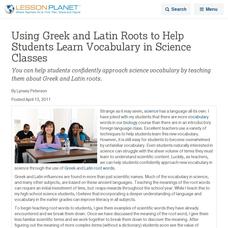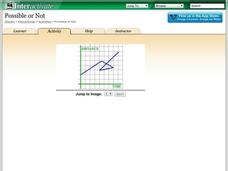Curated OER
Verb Forms
Regular and irregular verb forms are outlined in this catchy PowerPoint. After discussing the infinitive, simple present, simple past, past participle, and present participle forms of verbs, your scholars take a quick test that includes...
Curated OER
Keeping Your English Up to Date: Hoodie
Language is fluid, especially the English language. See how it is currently changing and will continue to change. Using the example of the term "hoodie," learners work through a week's worth of vocabulary, spelling, and critical thinking...
Curated OER
Colossal Squid Caught in Antarctic
Students define the word colossal, then read a news article about an enormous squid caught off Antarctica. In this animal studies and current events lesson, the teacher introduces the article with dictionary and vocabulary activities,...
Utah Education Network (UEN)
Insides and Outsides
Give small groups handfuls of unit cubes and then dare them to build as many rectangular prisms as possible using only 12 cubes. This engaging activity serves as an introduction to the volume of solid figures. In addition to volume,...
Curated OER
In God We Trust; All Others Pay Cash
Learners review their knowledge on the First Amendment. After reading an article, they identify specific church and state issues. Using the Internet, they research President Bush's proposal from a specific point of view. They summarize...
Curated OER
Spelling Unit- School Theme
In this school themed spelling unit, students study 12 more difficult words relating to school . Students complete a variety of activities with these words: dictionary work, definitions, scrambled words, and a word hunt.
Curated OER
Literature Study Guide - The Native Son
Explore Inez Haynes Gillmore's The Native Son with this thorough and engaging book report form. A reading schedule provides the opportunity to assign outside reading, and the other reading comprehension lessons could be completed in...
Curated OER
Literature Study Guide - Moby Dick
Complete with a reading schedule, literature question page, and supplementary list of literary activities, this book report form on Moby Dick would be an good resource for your junior high or high school class. The guide includes...
Curated OER
Substance Use, or Abuse?
Young scholars identify the medicinal benefits, and ill effects, of a variety of controlled substances. They determine whether or not they think hallucinogens should be researched for possible medicinal purposes.
Curated OER
Editing Skills
In this spelling worksheet, students edit, proofread and find the spelling mistakes in twelve sentences. Students correct each word they find spelt wrong.
Curated OER
Using Greek and Latin Roots to Help Students Learn Vocabulary in Science Classes
You can help students confidently approach science vocabulary by teaching them about Greek and Latin roots.
Curated OER
Using Pictures in the Classroom
Students review vocabulary by answering questions about an image, drawing the picture and taking notes. They compare their pictures and describe the differences.
Curated OER
Lexis: changing attitudes
Learners notice lexical items as chunks of language. They use grammar of multi words and are introduced to a lexical set connected to money. Students are given a chance to peer teach. They are encouraged to use dictionaries.
Shodor Education Foundation
Algorithm Discovery with Venn Diagrams
Here is a lesson that takes an interesting approach to analyzing data using box and whisker plots. By using an applet that dynamically generates Venn diagrams, the class forms a strategy/algorithm for guessing the rule that fits the...
University of California
Euclidean Geometry
Go back to where it all began! Investigate how axiomatic systems and Euclidean geometry are based on undefined terms, common notions, postulates, and propositions by examining passages from Euclid's Elements. (Social studies teachers...
Shodor Education Foundation
Sets and the Venn Diagram (Beginner)
Venn diagrams are helpful in understanding the idea of a set and using attributes to sort items. This basic plan is an introduction with an added bonus of an applet that can be used to demonstrate the activity. If a classroom of...
Curated OER
Thesaurus Power
Give your class the advantage of Thesaurus Power! They will use a thesaurus to understand word meanings and relationships. They focus on how a thesaurus functions and how it gives the entry word, definition, synonyms, antonyms, and part...
Common Sense Press
The Sign of the Beaver Vocabulary
A series of activities based on Elizabeth George Speare's The Sign of The Beaver takes your class through vocabulary, reading comprehension, and literary analysis. A good packet or collection of assignments for a reading circle.
Council for the Curriculum, Examinations and Assessment
Morals, Values, and Beliefs
What is integrity? What are the barriers that could keep a person from acting with integrity? How might these barriers be overcome? Class members tackle these questions as part of a course on Social, Physical, Emotional, Cognitive and...
Pala Software
SpellBoard
How do you spell great? G-R-E-A-T! Ensure that your pupils can spell great and so much more with this effective app.
Shodor Education Foundation
Buffon's Needle
Find the needle on a lined paper. Pupils run a simulation of dropping a needle on a lined paper. The probability of the needle crossing at least one line is pi/2. After each trial, the interactive displays the approximation of pi based...
Pearson
Advice: Should, Shouldn't, Ought to, Had Better, and Had Better Not
You shouldn't miss out on an opportunity to review should, shouldn't, ought to, had better, and had better not! Elementary and middle schoolers view a slideshow presentation that focuses on usage rules and examples for these tricky verbs.
Shodor Education Foundation
Linear Inequalities
An interactive lesson helps individuals learn to graph inequalities in two variables. Scholars can adjust the interactive to present the inequalities in standard or slope-intercept form.
Shodor Education Foundation
Possible or Not?
What does the graph mean? Pupils view 10 graphs and determine whether they are possible based on their contexts. The contexts are distance versus time and profit versus time.

























